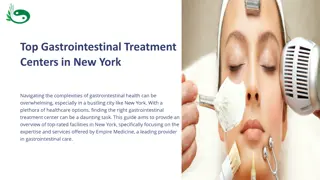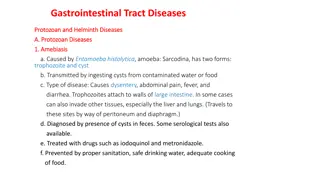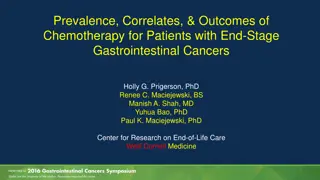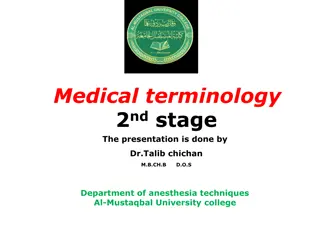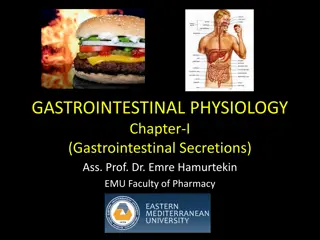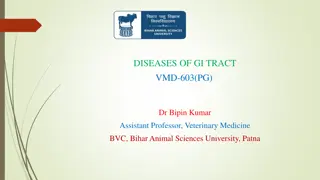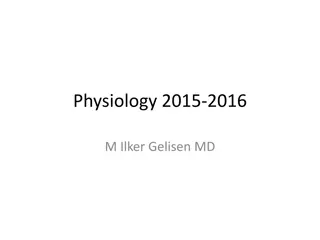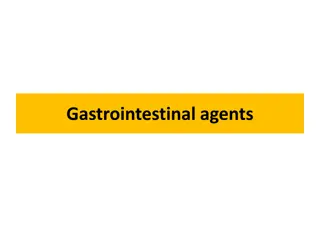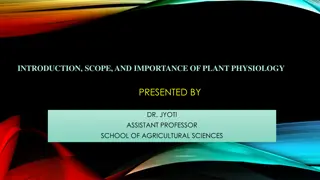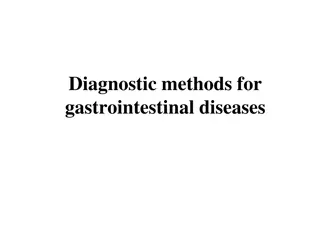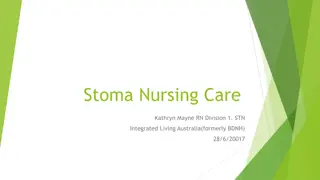Essential Overview of Gastrointestinal Physiology
Exploring the organization and general principles of gastrointestinal physiology, this content covers the anatomical and functional aspects of the GI system, including smooth muscle characteristics, neural control, blood flow, nutrient absorption, waste excretion, and regulatory functions like immunity and electrolyte balance.
Download Presentation

Please find below an Image/Link to download the presentation.
The content on the website is provided AS IS for your information and personal use only. It may not be sold, licensed, or shared on other websites without obtaining consent from the author. Download presentation by click this link. If you encounter any issues during the download, it is possible that the publisher has removed the file from their server.
E N D
Presentation Transcript
Organization and General Principles of Gastrointestinal Physiology Dr. Maha Saja Msaja@ksu.edu.sa
Objectives Objectives Physiologic anatomy of gastrointestinal wall The general characteristics of smooth muscle The specific characteristics of smooth muscle Control of gastrointestinal function (ENS) Types of neurotransmitters secreted by enteric neurons Functional types of movements in the gastrointestinal tract Gastrointestinal blood flow (Splanchnic circulation) Effects of gut activity and metabolic factors on GI blood flow
Introduction Introduction What is the GI system? What is the importance of the GI system?
What is the GI System? What is the GI System? A hollow tube from mouth to anus + accessory glands and organs. Hollow organs are separated from each other at key locations by sphincters. (Medical physiology: a cellular & molecular approach. Edited by Walter Boron and Emile Boulpaep. 2nd Ed.
Functions of the GI System Functions of the GI System The sedentary human body requires 30 kcal/Kg BW per day. This nutrient requirement is acquired through the GI system. The food we consume is not in a form that can be directly absorbed by the small intestine. (Medical physiology: a cellular & molecular approach. Edited by Walter Boron and Emile Boulpaep. 2nd Ed.)
Functions of the GI System Functions of the GI System The GI system processes consumed food mechanically & chemically to facilitate absorption. Dietary nutrient Consumed form Absorbed form Fat (lipids) Triglycerides Fatty acids Monoglycerides Proteins Proteins Large peptides Amino acids Carbohydrates Starch Disaccharides Monosaccharides ??
Functions of the GI System Functions of the GI System Excretion of waste material. Non-digested non-absorbed dietary products. Colonic bacteria & their products. Heavy metals (iron & copper). Organic cations & anions (e.g. drugs) Regulation of water & electrolyte balance. Immunity.
FUNCTIONAL ANATOMY FUNCTIONAL ANATOMY OF THE WALL OF THE OF THE WALL OF THE GIT GIT
The Wall of the GI tract The Wall of the GI tract The anatomy of the wall varies but there is a common general theme.
To understand the characteristics of the wall of the GIT, we must talk about the general characteristics of smooth muscles. https://youtu.be/yzQAgfivX74
SMOOTH MUSCLE SMOOTH MUSCLE
Types of Smooth Muscle Types of Smooth Muscle Two major types Multi-unit Single-unit Smooth Ms Smooth Ms
Examples of the Different Types Examples of the Different Types of Smooth Muscle of Smooth Muscle
Contractile Mechanism of Contractile Mechanism of Smooth Muscle Smooth Muscle
Molecular Basis of Smooth Molecular Basis of Smooth Muscle Contraction Muscle Contraction
[Ca+2]i Ca+2 binds to calmodulin Ca-CaM complex activates MLCK Phosphorylates Myosin head increasing the activity of ATPase Myosin head attaches to actin causing sliding of the filaments
How Does Smooth Muscle How Does Smooth Muscle Contraction Stop? Contraction Stop? 1. A drop in [Ca+2]i deactivates MLCK. 2. In addition, the phosphorylated myosin heads need to be dephosphorylated (deactivated) by Myosin Phosphatase Relaxation Relaxation
Types of Smooth Muscle Types of Smooth Muscle Contraction Contraction Types of smooth muscle activity pattern Phasic Tonic Smooth muscle cells contract rhythmically or intermittently. Contraction followed by relaxation. e.g. walls of the GI tract. Smooth muscle cells continuously active maintaining a tone . Continuous partial contraction. e.g. vascular & respiratory smooth muscle, sphincters.
Control of Smooth Muscle Control of Smooth Muscle Contraction Contraction Unlike skeletal muscle, smooth muscle can be stimulated to contract by many types of signals; Nervous signals. Hormonal signals. Mechanical signals (e.g. stretch). Pacemaker activity.
Nervous Control of Smooth Nervous Control of Smooth Muscle Contraction Muscle Contraction Autonomic neuron. Axons have multiple varicosities. Ach & NA. Somatic neuron. Branching end feet. Ach.
Control of Smooth Muscle Control of Smooth Muscle Contraction Contraction In smooth muscle contraction can happen in the absence of an action potential.
Now that we discussed the general characteristics of smooth muscles, lets go back to GI smooth muscles. GASTROINTESTINAL GASTROINTESTINAL MOTILITY MOTILITY
GI Smooth Muscle GI Smooth Muscle Each muscle layer functions as a syncytium. A few connections exist between circular & longitudinal muscle layers.
Electrical Activity of GI Electrical Activity of GI Smooth Muscle Smooth Muscle What is the Resting membrane potential for smooth muscle cells? And at what level is the threshold? Two basic types of electrical waves are seen in the GIT Slow waves Spike potentials Rhythmic oscillations in RMP of 5-15mv with variable frequency depending on region. Stomach = 3/min Duodenum = 12/min Ileum = 8-9/min Are true action potentials. The frequency of spike potentials depends on the extent of increase in slow wave potential above the level of threshold.
Slow Waves vs Spike Potential Slow Waves vs Spike Potential What do you notice from the graph? And what is the cause of; Slow waves. Spike potentials.
What Happens if the RMP is What Happens if the RMP is Changed? Changed? Factors that cause the RMP to become less negative (stretch, Ach, some GI hormones) Norepinephrine & Epinephrine.
Control of GI Function Control of GI Function Neural control; Enteric nervous system (ENS). Autonomic nervous system. Hormonal control. GI contents.
Neural Control of GI Function Neural Control of GI Function The Enteric Nervous System The Enteric Nervous System The GIT has a nervous system of it own Enteric nervous system . Its function is largely independent of the extrinsic nervous system mini-brain . Composed of 2 main plexuses Myenteric Submucosal Meissner s Plexus Auerbach s Plexus
The Enteric Nervous System The Enteric Nervous System
Myenteric vs Submucosal Myenteric vs Submucosal Plexus Plexus Submucosal plexus Myenteric plexus Located in the muscle layer between longitudinal & circular muscle layers. Controls GI movement. Found throughout the GIT. Located in the submucosa. Controls GI secretion & local blood flow. Only in the small & large intestine.
Autonomic Control of GIT Autonomic Control of GIT Sympathetic Parasympathetic
GI Reflexes GI Reflexes 3 types of reflexes Integrated at spinal cord/brain stem Integrated at Sympathetic ganglia Integrated within the ENS Gastro-colic reflex Entero-gastric reflex Colono-ileal reflex Pain reflexes Defecation reflex Control local effects; GI secretion Peristalsis Mixing movement
Hormonal Control of GI Hormonal Control of GI Function Function https://www.sciencelearn.org.nz/resources/1836-hormonal-control-of-digestion
Types of Movement in the Types of Movement in the GIT GIT Motor activity of the GIT Propulsive movement Mixing movement Peristalsis Segmentation Progressive wave of contraction & relaxation. Move GI content in a caudal direction. Non-propulsive segmental contractions. Cause mixing and chopping of intestinal content. Law of the Gut Distension of bowel contraction of circular muscle & relaxation of longitudinal ms in upstream segment + the opposite in the downstream segment. Due to contraction of circular muscle + relaxation of receiving segment.
Types of Movement in the Types of Movement in the GIT GIT Peristalsis Segmentation
Does the Bowel Move in the Does the Bowel Move in the Fasting State? Fasting State? Migrating motor complexes (MMC). Every 90- 120min. 4 phases. What hormone is implicated and what is the purpose of it?
Splanchnic Circulation Splanchnic Circulation Read from Guyton & Hall Textbook of Medical Physiology. Chapter 62. 12th ed.







